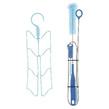


| < - > Bike — Sitting — Be heard — Push-back — Shield-oneself — Transport — Trailer — GPS — Drink — Camping — Energy |
DRINK IN CYCLO-HIKING
We have detailed in Facilitate effort the need to drink before you get thirsty… therefore to drink regularly.


traîner une barrique à roulette…
Mais tout cela nécessitait de s'arrêter pour s'hydrater. Donc nous nous sommes transformés en chameau-jerrican, en nous greffant un sac à eau (sac à dos à eau).
WATER BAGPACK
We had several water bags. The best of them all is the Camelbak:
- Lightweight.
- Very compact.
- Very easy to fill.
We had previously chosen the high-capacity CamelBak Classic 3L (3 litres) model. It allowed the daily consumption (except in case of extreme heatwave). But it had the disadvantage of pulling too much on the shoulders.
We switched to CamelBak-HydroBak-1.5L (1.5 litres). In practice its actual filling is actually limited to 1.1 litres. In use since 2012 we have NEVER had any shoulder or back pain.
Its water bag is very easily filled at the tap, because the upper opening (closed by a screw cap at 1/6th of a turn) is generously dimensioned.
TIP for SUCTION PLUG:
Suction flow is too limited. In fact, this flow is only limited by the slot in the blue suction tip. To avoid this limitation, simply insert a thin, sharp knife into the slot of the nozzle. Once slightly in one direction, and once slightly in the other. This widens the slot at both ends and provides a comfortable suction flow!
TIP for WATER BAG :
Outside the touring cycling period you may want to use it from time to time, for example at weekends. In this case the Maintenance process described below is too cumbersome.
To maintain good hygiene without complications, the simplest way to do this is to :
- remove the suction mouthpiece,
- Shake well in all directions to remove all water, including in the hose,
- put it in a plastic bag,
- put the bag in the freezer
WATER RESERVE
In order to be able to stay independent during a full day of cycling, it is good to bring 3 litres of water per person.
On our bike frames, all the water bottle holders are occupied by tool cans. Therefore, the water must be stored elsewhere. The configuration adopted depends on the type of cycling, with or without camping.
WATER RESERVE WITH CAMPING LOAD
In cyclo-camping touring mode without trailer our front panniers are large 40 litre panniers identical to the rear panniers. The size and weight of these saddlebags are too big to add the attachment of water bottles.
In this mode, which we have been practicing since 2014, we have replaced the water reserve cans by water-bag 2 liters - ORTLIEB.
The total takeaway per person is therefore 3.1 litres (1.1+2). When the water bag bag is empty we take advantage of a stop to transfer part of the cow into the bag.
For fixing see page Luggage Transport
WATER RESERVE WITHOUT CAMPING LOAD
Before camping, our front panniers were ORTLIEB FRONT ROLLER CLASSIC.
In this size it is easy to add the accessories "Ortlieb Bottle cage" on the front of the bags.
Nous avions 2 bidons 0,8 litres par vélo. Le total par personne était ainsi de 2,7 litres (1,1+0,8+0,8).
HOW TO CLEAN YOUR WATER POCKET - ORDINARY CLEANSING
When the period of regular use on a cycle tour is over, a few precautions should be taken to ensure the durability of the water bag.
Indeed, if it is stored as it is, it is certain that a few weeks or months later the bag will contain black traces of internal mould in the bag and in the pipe.
So how do you clean the water pocket? The best way is to buy a "Pocket cleaning kit" (article 5935596) from Décathlon.
It includes:
- A spacer on a hanger.
- A big pipe cleaner.
- A fine brush with a very long flexible stem.
All you have to do then is apply the following little procedure:
- Remove the suction nozzle at the end of the water bag tube.
- Clean the water bag tube by inserting the long-stemmed fine wire brush into the tube.
- Clean the water bag with the coarse brush.
- Blow into the tube to remove as much water as possible.
- Empty the water bag of all water.
- Insert the spreader into the water pocket.
- To dry 2 solutions:
- The fastest and most efficient is the OVEN DRYING (electric):
- Set the oven temperature to 60°.
- Place the pouch-tube assembly in the oven.
- Allow the necessary time for all traces of water to disappear from the pouch and tube (often 1 hour).
- NATURAL DRYING. Hang upside down (large pocket filling hole at the bottom:
- This ensures that any remaining water does not accumulate at the bottom of the pocket, but can flow out, which from the bottom of the tube, through the filling opening.
- The hook of the spreader that comes out of the pocket is therefore useless.
- If this hook was used as designed, with the bag positioned in this way (large filling opening at the top), the internal drainage water would accumulate and stagnate.
- The fastest and most efficient is the OVEN DRYING (electric):
HOW TO CLEAN YOUR WATER POCKET - CURATIVE CLEANSING
If water is inadvertently left standing in the pouch for too long without being used, blackish odours, lumps and filaments will appear (bacterial growth).
Conventional cleaners are ineffective. As for the use of bleach, it is excluded, because it would be too aggressive for the plastic of the water pouch.
But, DO NOT THROW IT OUT, there is a solution. You have to clean your water pocket intensively. This requires the use of a very old and very common product in the decontamination of drinking water networks.… THE POTASSIUM PERMANGANATE.
BUT ATTENTION - ATTENTION - ATTENTION :
- Potassium Permanganate STAINS (SKIN AND OBJECTS) STRONG AND FOR LONG TIME.
- On the skin the stains can remain for several weeks!!!
- So put on blouse, gloves…
- Swallowing it is as dangerous as bleach… STOP CHILDREN.
- For more details on the nature of the product, see its data sheet onWikipedia
It is bought in pharmacies and sold in individual sachets (factory sealed) of a few grams each.
- Rinse the bag 3 or 4 times with clean water.
- Prepare a solution of water and potassium permanganate diluted to 0.15g/l.
- Fill the pouch with the solution
- Allow decontamination to take effect with a contact time of at least 24 hours.
- Rinse at least 5 times
In all cases of the above fillings (rinse 1, solution decontamination, 5 rinses)
- Fill the FOND pocket.
- Close the pocket.
- Open the mouthpiece.
- Remove any air bubbles from the mouth opening by squeezing the pouch.
- Passing liquid (rinse or solution)
- Close the mouthpiece
BUT ATTENTION - ATTENTION - ATTENTION :
- Do NOT MINIMIZE the rinsing steps.
- Ingesting permanganate will get you to the hospital!!!
- Consider it as dangerous as Chlorine, as dangerous as bleach…
AUXILIARY FUNCTION OF THE WATER BACKPACK
If we have to drive at night we put on a safety vest completely in order to benefit from the reflective stripes on all sides, even towards the front.
In cyclo touring, where we ride during the day, the most important thing is to be seen from behind and from the sides.
Also to stay comfortable and avoid getting too hot, while being safe we put the vest on the water bag. With our old 3L CamelBak we used to put an adult waistcoat on the bag. Now, with the 1.5L CamelBak we put a junior vest on the bag.
Mouthpiece at your disposal.
Photo with the 3L, actually the 1.5L
does not have a recall lanyard
across the chest.
Which is more comfortable.
WINTER DRINKING
During the winter the water quickly becomes icy. This is very unpleasant and bad.
There is an excellent ALL-INSULATED solution, the CAMELBAK SCORPION:
- The water pocket is insulated.
- The tube is insulated.
- The insulated tube and its end tutte are stored well away from the cold in the strap, which is itself insulated.
Difficult to find in France, we ordered it from Amazon-Usa.





